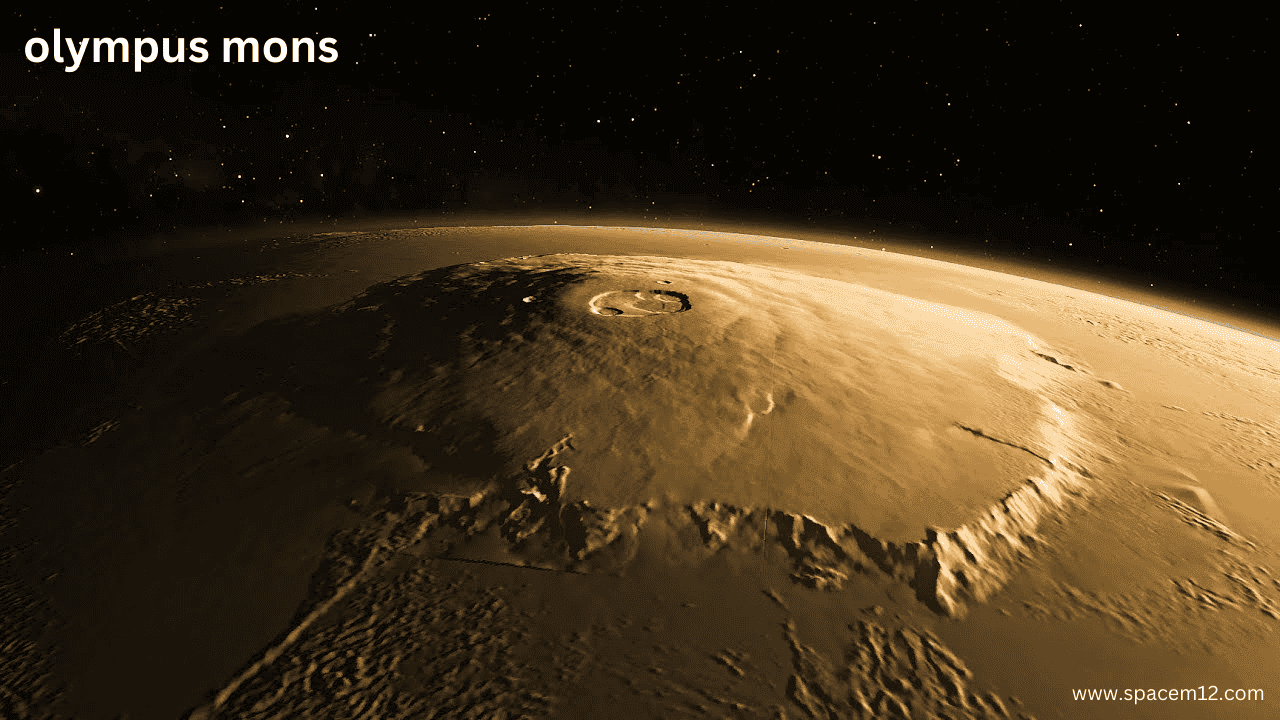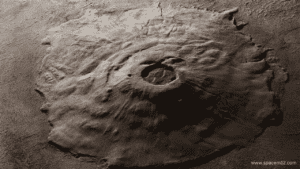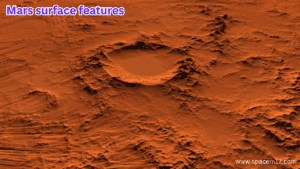Olympus Mons – The Tallest Volcano in the Solar System
Olympus Mons, the tallest well of lava in the nearby planet group, overshadows the Martian surface with a stunning level of roughly 13.6 miles (22 kilometers), almost multiple times the level of Mount Everest. This huge safeguard well of lava, situated in Mars’ western half of the globe, is important for the Tharsis volcanic locale. Its tremendous size, spreading over 370 miles (600 kilometers) in width, makes Olympus Mons a prevailing aspect of Mars’ geology.
The delicate inclines of the fountain of liquid magma, shaped by the progression of profoundly liquid magma, stretch outwards, making a gigantic base that covers a region generally the size of France. Researchers accept that the well of lava shaped through rehashed ejections more than great many years, adding to its huge scope.
What separates Olympus Mons is its interesting geographical history and the ramifications it has for grasping Mars’ volcanic movement. Albeit the well of lava is at present torpid, proof proposes it may not be totally wiped out, bringing up issues about future ejections. The absence of structural plate development on Mars has permitted Olympus Mons to develop to such outrageous levels, not at all like Earth’s volcanoes, which are confined by moving plates.
Moreover, Olympus Mons has been a critical concentration for planetary researchers, as concentrating on its development and construction gives experiences into Mars’ land past and potential for volcanic action. Understanding the historical backdrop of this gigantic spring of gushing lava is pivotal, particularly as humankind thinks about future missions to Mars and the chance of long haul colonization in the world. The investigation of Olympus Mons develops our insight into Mars as well as energizes interest in the circumstances for life on different planets.
What is Olympus Mons?
Location of Olympus Mons on Mars
Olympus Mons is situated in the western side of the equator of Mars, situated at roughly 18.65°N scope and 226.2°E longitude. It rules the Tharsis volcanic level, a district that is home to probably the biggest volcanoes in the planetary group. This locale, known as the Tharsis swell, transcends the encompassing Martian fields and stretches north of 2,500 miles (4,000 kilometers) across. The raised idea of the Tharsis level, joined with the tremendous size of Olympus Mons, creates the spring of gushing lava a striking component that could be spotted from space. Its transcending level and expansive base make it a focal milestone in Mars’ geography, adding to the planet’s general geology and impacting barometrical examples.
The arrangement of Olympus Mons on Mars is topographically huge. The Tharsis locale, where it dwells, is remembered to have framed because of volcanic action that has formed a large part of the planet’s surface north of billions of years. The enormous load of Olympus Mons and other close by volcanoes, like Ascraeus Mons and Pavonis Mons, has made the planet’s hull droop under their huge size, adding to structural burdens.
The absence of structural plate development on Mars permits volcanic movement to stay gathered in regions like Tharsis, bringing about the huge size of Olympus Mons. This static outside layer has led to a significant stretch of volcanic movement in the district, making it quite possibly of the most concentrated on region on Mars. Researchers accept that the Tharsis lump, and Olympus Mons specifically, hold basic signs to figuring out the geographical history of Mars and the development of its surface.
How Was Olympus Mons Formed?
Olympus Mons was shaped through a progression of volcanic ejections that happened north of millions of years, constructing the huge safeguard spring of gushing lava we see today. The interaction started with magma ascending from profound inside Mars’ mantle, pushing through the planet’s covering and emitting onto the surface. Not at all like the more hazardous volcanoes on The planet, Olympus Mons experienced rehashed ejections of low-thickness basaltic magma, which streams effectively and spreads across huge distances.
These progressive magma streams layered north of each other, making the expansive, tenderly slanting construction normal for safeguard volcanoes. The shortfall of structural plate development on Mars permitted the volcanic movement to stay gathered in one spot, which empowered Olympus Mons to develop to its amazing level of 13.6 miles (22 kilometers), almost multiple times the level of Mount Everest.
The Tharsis locale, where Olympus Mons is found, likewise assumed a vital part in its development. This locale is an immense volcanic level that shaped because of the collection of volcanic material more than billions of years. As magma kept on ascending from the mantle, the surface above it swell, making the Tharsis swell, and volcanic movement became engaged around here. The absence of plate tectonics on Mars implied that the magma chamber underneath Olympus Mons was not uprooted after some time, dissimilar to Earth’s volcanic areas of interest, which move because of moving plates.
Accordingly, Olympus Mons had the option to encounter significant stretches of volcanic movement at a similar area. The heaviness of the spring of gushing lava made the hull underneath it sink, making a slight sorrow around the fountain of liquid magma’s base. These land processes have prompted Olympus Mons becoming the tallest spring of gushing lava on Mars as well as the biggest known in the whole planetary group.
Size and Structure of Olympus Mons
Comparison with Earth’s Volcanoes
While contrasting Olympus Mons with Earth’s volcanoes, the size distinction is faltering. Olympus Mons remains at 13.6 miles (22 kilometers) high, almost multiple times the level of Mount Everest, and ranges around 370 miles (600 kilometers) in width. The biggest well of lava on The planet, Mauna Loa in Hawaii, arrives at a level of around 6.3 miles (10.2 kilometers) when estimated from its base on the sea depths, yet its general size fails to measure up to Olympus Mons.
Safeguard volcanoes on both Earth and Mars share comparative expansive, delicate slants, which are brought about by the progression of low-thickness magma, however the size of Olympus Mons is made conceivable because of the one of a kind land conditions on Mars. The absence of structural plates on Mars implies there is no outside development, permitting a similar volcanic area of interest to stay dynamic for a long period of time in one area, bringing about the colossal size of Olympus Mons.
Interestingly, Earth’s structural movement makes volcanic areas of interest shift over the long haul. For instance, Hawaii’s volcanoes, including Mauna Loa and Kilauea, structure over a moving area of interest, meaning once a fountain of liquid magma ejects for a period, it ultimately creates some distance from the area of interest and becomes lethargic as new volcanoes structure. This steady moving limits the size of any single well of lava on The planet.
Besides, Earth’s climate and gravity likewise assume a part in restricting the level of its volcanoes. Mars’ lower gravity permits Olympus Mons to become taller than any well of lava on The planet, while its slim environment prompts less disintegration, permitting the enormous design to remain generally in one piece over the long haul. This makes Olympus Mons a topographical marvel as well as a remarkable case in planetary science.
Height, Diameter, and Slope Details
Olympus Mons holds the title as the tallest spring of gushing lava in the nearby planet group, remaining at an amazing 13.6 miles (22 kilometers) high. To place this in context, it is almost multiple times the level of Mount Everest, Earth’s tallest pinnacle, which rises simply over 5.5 miles (8.8 kilometers) above ocean level. What really separates Olympus Mons, be that as it may, is its tremendous measurement. Extending around 370 miles (600 kilometers) across, it covers a region generally the size of the territory of Arizona.
The sheer size of the spring of gushing lava intends that, from base to top, the slants of Olympus Mons are extraordinarily delicate. With a typical slant of simply 2 to 5 degrees, the slope is progressive to such an extent that an eyewitness remaining on the outer layer of Mars wouldn’t promptly see it as a gigantic mountain — its curve would stretch out a long ways into the great beyond.
The delicate slant of Olympus Mons is run of the mill of safeguard volcanoes, which structure from the sluggish, consistent flood of exceptionally liquid basaltic magma. This magma can travel huge spans prior to cementing, which permits Olympus Mons to fan out over such a far reaching region. The slant of the fountain of liquid magma is a consequence of this kind of magma stream, which makes wide, shallow grades as opposed to steep, sensational pinnacles like those seen in stratovolcanoes on The planet. Also, the huge caldera at the culmination of Olympus Mons, which estimates around 50 miles (80 kilometers) in width, adds to its special design.
The caldera framed as the culmination imploded after magma was removed from the spring of gushing lava, making a tremendous despondency that denotes the most elevated place of the Martian scene. This blend of colossal level, tremendous distance across, and steady slant makes Olympus Mons perhaps of the most astounding volcanic component in the planetary group.
The Caldera of Olympus Mons
The caldera of Olympus Mons is a characterizing component of this gigantic Martian spring of gushing lava. Situated at the culmination, the caldera is a huge wretchedness that actions about 50 miles (80 kilometers) in width, making it as wide as probably the biggest urban communities on The planet. This gigantic caldera shaped because of the spring of gushing lava’s magma chamber discharging during ejections. After the magma was launched out, the heaviness of the highest point could presently not be upheld, making the surface breakdown and structure a huge, multi-layered hole.
The caldera of Olympus Mons comprises of a few covering more modest cavities, which recommend that the spring of gushing lava went through different phases of breakdown over its long history of volcanic action.
The development of such an enormous caldera is a critical sign of Olympus Mons’ colossal size and the size of its ejections. On The planet, volcanoes like Mauna Loa and Yellowstone additionally have calderas, however none methodology the size of Olympus Mons’. The way that Olympus Mons’ caldera traverses a wide region features the massive volume of magma that once ejected from this Martian spring of gushing lava. The profundity of the caldera, which arrives at up to 2 miles (3 kilometers) in certain parts, offers understanding into the size of magma seepage that happened underneath the surface
. Concentrating on the design and layers of the caldera assists researchers with figuring out the volcanic cycles that formed Olympus Mons and gives important insights about the land history of Mars. The caldera’s huge region likewise brings up issues about the potential for future volcanic action, as it might in any case be associated with profound magma repositories underneath the Martian surface.
Exploration and Scientific Discoveries
Space Missions That Have Studied Olympus Mons
A few space missions have concentrated on Olympus Mons to accumulate information about its huge design and land history, offering bits of knowledge into the idea of volcanic action on Mars. NASA’s *Mariner 9* was the primary space apparatus to catch nitty gritty pictures of Olympus Mons in 1971. As the main rocket to circle another planet, Mariner 9 gave phenomenal perspectives on Mars, including Olympus Mons, uncovering its huge scope and affirming it as the tallest fountain of liquid magma in the planetary group.
The information from Mariner 9 altered’s comprehension researchers might interpret Martian geography and brought up new issues about the planet’s volcanic past. Following *Mariner 9*, the Viking 1 and Viking 2 orbiters, sent off in 1975, kept on concentrating on the area, delivering more itemized pictures and planning the surface elements of Olympus Mons, including its caldera and encompassing magma fields.
In later years, missions, for example, NASA’s Mars Worldwide Surveyor*, *Mars Odyssey*, and *Mars Observation Orbiter* have given high-goal pictures and geological information that have essentially progressed how we might interpret Olympus Mons. The *Mars Worldwide Surveyor* (1996) utilized its Mars Orbiter Laser Altimeter (MOLA) to make point by point rise guides of Olympus Mons, permitting researchers to quantify the well of lava’s level and slants with extraordinary accuracy.
The *Mars Odyssey* orbiter, sent off in 2001, utilized warm imaging to concentrate on the structure of the surface around Olympus Mons, offering experiences into the kinds of magma streams that shaped the spring of gushing lava. The *Mars Observation Orbiter* (2006) gave the absolute most itemized pictures to date, catching complex subtleties of Olympus Mons’ surface, including proof of avalanches and magma channels. Together, these missions have developed how we might interpret Olympus Mons as well as added to more extensive information about the historical backdrop of volcanic action on Mars and its true capacity for future ejections.
Geologic Activity and Age of Olympus Mons
Olympus Mons is assessed to be between 200 million and 2 billion years of age, making it a moderately youthful fountain of liquid magma in land terms. Researchers accept that Olympus Mons was framed by various emissions over a significant stretch, permitting the enormous safeguard spring of gushing lava to develop layer by layer. These ejections are remembered to have happened during Mars’ Hesperian and Amazonian periods, times set apart by huge volcanic and structural action.
Not at all like a significant number of Earth’s volcanoes, which are many times obliged by structural plate development, Olympus Mons developed to its massive size because of the shortfall of dynamic plate tectonics on Mars. This permitted magma from a fixed magma source underneath the surface to stream more than once in a similar region, slowly collecting and shaping the transcending structure we see today.
Despite the fact that Olympus Mons is as of now named a lethargic fountain of liquid magma, there is proof proposing that it may not be totally terminated. A few surface highlights, for example, generally youthful magma streams, demonstrate that volcanic movement might have happened as of late as a long time back. The presence of these more youthful magma stores indicates that Olympus Mons could in any case have the potential for future emissions, despite the fact that there has been no new action.
Its gigantic caldera and encompassing magma fields keep on giving hints about its volcanic history, and planetary researchers are concentrating on the likelihood that magma supplies might in any case exist underneath the surface. Understanding the geologic movement and period of Olympus Mons is significant for deciphering the volcanic development of Mars, particularly as future missions to the Red Planet might additionally investigate its true capacity for progressing or future volcanic action.
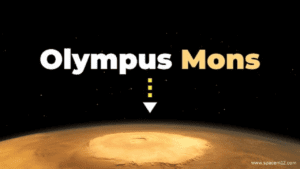
Could Olympus Mons Erupt Again?
Dormant vs. Extinct Volcanoes
Volcanoes can be arranged into three fundamental classes in light of their movement: dynamic, lethargic, and terminated. A lethargic fountain of liquid magma is one that has not ejected in a lot of time but rather still can possibly emit once more. These volcanoes may give indications of past volcanic action, for example, new magma streams, fumaroles, or seismic action, showing that magma might in any case be available underneath the surface.
Olympus Mons is in many cases thought about a lethargic fountain of liquid magma, as there is proof of moderately youthful magma streams and geographical highlights that propose it might actually emit again from here on out. The absence of structural plate development on Mars permits Olympus Mons to keep up with its magma supply over a drawn out period, making the chance of a future emission conceivable.
Conversely, a wiped out fountain of liquid magma is one that has not ejected for quite a while — regularly a long period of time — and gives no indications of volcanic movement or the potential for future emissions. These volcanoes have as a rule cooled totally, and their magma supplies have either been drained or cemented, making it profoundly far-fetched for them to emit once more. Instances of terminated volcanoes can be found on The planet, for example, the Edinburgh Spring of gushing lava in Scotland, which has not shown any volcanic movement for around 350 million years.
Understanding the qualification among torpid and terminated volcanoes is fundamental for evaluating volcanic dangers and making arrangements for future land occasions. On account of Olympus Mons, the grouping as lethargic as opposed to terminated welcomes progressing examination and observing, particularly as researchers try to grasp the more extensive ramifications of volcanic movement on Mars and its geographical history.
Impact on Future Mars Missions
The investigation of Olympus Mons has huge ramifications for future Mars missions, especially those pointed toward figuring out the planet’s topography and surveying its true capacity for human investigation. As the tallest well of lava in the planetary group, Olympus Mons offers an extraordinary chance to research volcanic cycles and Martian history. Understanding the arrangement and movement of this huge design can give bits of knowledge into the planet’s geographical advancement and assist researchers with creating models for its volcanic past.
Future missions might incorporate landers or wanderers explicitly intended to concentrate on Olympus Mons, zeroing in on its surface sythesis, the attributes of its magma streams, and the period of different geographical elements. This examination will be fundamental for establishing a far reaching comprehension of Mars’ environment and possible tenability, which is critical for long haul human investigation and colonization.
Moreover, the chance of Olympus Mons being a torpid well of lava brings up issues about likely volcanic perils for future missions. Assuming volcanic movement were to continue, it could present dangers to both automated and human wayfarers. Grasping the indications of volcanic action, like gas outflows, seismic movement, or changes in the scene, will be fundamental for mission arranging and wellbeing conventions. Missions might have to consolidate observing frameworks to distinguish volcanic action, guaranteeing that travelers can answer actually to any progressions in the climate.
Also, concentrating on Olympus Mons could illuminate the quest for assets, for example, water or minerals, which might be available in volcanic materials. In general, the investigation of Olympus Mons isn’t just basic for figuring out Mars’ land history yet additionally assumes a pivotal part in molding the fate of Mars investigation and the wellbeing of human missions to the Red Planet.
The Role of Olympus Mons in Mars’ Geology
Influence on Mars’ Atmosphere and Climate
Olympus Mons plays had a critical impact in forming Mars’ environment and environment all through the planet’s land history. As the biggest well of lava in the planetary group, it has impacted the dispersion of environmental gases and the elements of weather conditions on Mars. Volcanic emissions discharge different gases, including carbon dioxide, water fume, and sulfur dioxide, which can add to the nursery impact.
Despite the fact that Mars’ air is as of now slender, the presence of these gases in the past might have assisted with warming the planet, conceivably making conditions that were better for fluid water on a superficial level. This might have had significant ramifications for the improvement of an early Martian environment that could have upheld microbial life.
Besides, the sheer size and geographical movement of Olympus Mons might have added to the arrangement of residue tempests and atmospheric conditions on Mars. The intensity produced by the spring of gushing lava, joined with its rise, could prompt limited air aggravations, influencing wind designs and adding to the planet’s infamous residue storms. These residue tempests can wrap enormous region of the planet, affecting surface temperatures and air conditions.
Moreover, the age and history of volcanic action at Olympus Mons might give bits of knowledge into the drawn out climatic changes that Mars has encountered, including changes from a hotter, wetter climate to the chilly, dry scene noticed today. Understanding the impact of Olympus Mons on Mars’ air and environment is essential for disentangling the planet’s past and surveying its true capacity for future livability, which stays a vital concentration for continuous and future Mars investigation missions.
Connection to Tharsis Region Volcanism
Olympus Mons is a focal component of the Tharsis district, a huge volcanic level on Mars portrayed by a group of enormous safeguard volcanoes. The Tharsis locale, which traverses north of 2,500 kilometers (around 1,550 miles) across, is home to a few other critical volcanoes, including Ascraeus Mons, Pavonis Mons, and Arsia Mons.
This grouping of volcanic movement is remembered to have begun from a fixed area of interest in the Martian mantle, where magma has persistently ascended to the surface, considering the development of various volcanoes throughout land time. Olympus Mons, as the biggest and generally conspicuous of these volcanoes, gives important experiences into the volcanic history and cycles that have formed the Tharsis district as well as the whole Martian surface.
The association between Olympus Mons and the more extensive Tharsis locale is fundamental for figuring out Mars’ topographical advancement. The Tharsis volcanic movement has likely assumed a critical part in modifying the planet’s scene, adding to the improvement of huge magma streams and other land highlights. Furthermore, the huge load of Olympus Mons and its adjoining volcanoes has made the Martian outside droop, making a geographical discouragement that portrays the Tharsis locale.
This land action might have affected the Martian environment by delivering gases into the climate, influencing air strain and temperature. The exchange of these volcanic elements has significant ramifications for grasping the historical backdrop of volcanic movement on Mars, as well as the potential for future ejections. Concentrating on Olympus Mons with regards to the Tharsis locale permits researchers to sort out a more complete image of Mars’ volcanic scene and its dynamic land history.
Fun Facts About Olympus Mons
How Olympus Mons Got Its Name
Olympus Mons, the biggest spring of gushing lava in the planetary group, gets its name from the old Greek word “Olympus,” which alludes to Mount Olympus, the most noteworthy mountain in Greece and the legendary home of the Greek divine beings. The name was first proposed by the American cosmologist and planetary researcher Carl Sagan during the last part of the 1970s while talking about the planet Mars and its geographical highlights.
The expression “Mons,” which is Latin for “mountain,” was added to connote the spring of gushing lava’s gigantic height, in this manner assigning Olympus Mons as “Mount Olympus.” The name mirrors the fountain of liquid magma’s noteworthy level as well as summons the loftiness related with its legendary namesake, catching the creative mind of researchers and the public the same.
The naming of Olympus Mons likewise follows a show utilized by the Global Galactic Association (IAU), which relegates names to highlights on divine bodies in light of folklore, history, and social importance. Mars includes different topographical names roused by traditional folklore, and Olympus Mons fits impeccably inside this unique situation.
The spring of gushing lava’s name underlines its unmistakable quality in the Martian scene and features the association between how we might interpret planetary science and old human culture. As perhaps of the most concentrated on geographical element on Mars, the name Olympus Mons fills in as a sign of both the spring of gushing lava’s striking scale and the rich history of investigation and disclosure that keeps on unfurling on the Red Planet. The name has become inseparable from Mars’ volcanic movement and stays a point of convergence in conversations about the planet’s geography and potential for past tenability.
Comparison with Mount Everest and Mauna Kea
Olympus Mons remains as an epic goliath when contrasted with Earth’s tallest mountains, especially Mount Everest and Mauna Kea. Mount Everest, situated in the Himalayas, is the most noteworthy top on The planet, transcending at around 29,032 feet (8,848 meters) above ocean level. Interestingly, Olympus Mons arrives at an amazing level of roughly 13.6 miles (22 kilometers), making it almost multiple times taller than Everest. This enormous rise is made conceivable by Mars’ lower gravity, which takes into account the development of a lot bigger volcanic designs than those conceivable on The planet.
While Everest’s level is impacted by structural plate cooperations, prompting a lofty, rough profile, Olympus Mons grandstands a wide, tenderly slanting construction normal for safeguard volcanoes, worked from layers of liquid basaltic magma that spread over tremendous distances.
When contrasted with Mauna Kea, one more unmistakable fountain of liquid magma on The planet, Olympus Mons additionally uncovers obvious contrasts in size and arrangement. Mauna Kea ascends around 33,500 feet (10,210 meters) when estimated from its base on the sea floor, making it the tallest mountain on the planet from base to highest point. Notwithstanding, while considering the noticeable piece above ocean level, Mauna Kea remains at just 13,796 feet (4,205 meters), which is essentially more limited than Olympus Mons.
Like Olympus Mons, Mauna Kea is a safeguard fountain of liquid magma framed by rehashed magma streams. However, Mauna Kea’s action is impacted by Earth’s structural plate developments, which lead to a more different volcanic history and the making of more limited, more extreme pinnacles. In rundown, while Olympus Mons midgets both Mount Everest and Mauna Kea as far as level and volume, the land processes that shape these mountains delineate the intricacies of planetary geography across various divine bodies.
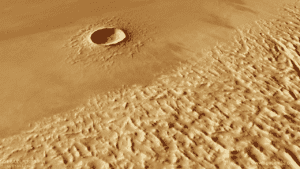
Conclusion
Olympus Mons remains as a demonstration of the powerful topographical history of Mars, addressing not just the tallest fountain of liquid magma in the planetary group yet in addition a critical point of convergence for logical investigation into planetary cycles. Its huge level, broad width, and remarkable caldera give priceless experiences into the volcanic movement that has formed the Martian scene. Correlations with Earth’s noticeable mountains, for example, Mount Everest and Mauna Kea, feature the distinctions in land processes and planetary circumstances, showing how the shortfall of structural plate development on Mars has permitted Olympus Mons to accomplish such uncommon aspects.
Understanding Olympus Mons is significant for disentangling the historical backdrop of Mars and evaluating its true capacity for past and future livability. The examinations directed through different space missions have enlightened its arrangement, age, and association with the Tharsis volcanic area, adding to our more extensive information on Martian geography and environment. As investigation of Mars proceeds, Olympus Mons will stay a critical area of premium, directing future missions pointed toward grasping the volcanic cycles on Mars as well as the ramifications for human investigation and the quest forever. At last, Olympus Mons fills in as a sign of the miracles of our planetary group and the significance of continuous logical investigation in opening the mysteries of different universes.
